Erica Vetsch's Blog, page 65
March 27, 2021
Sunday Scripture & Prayer Requests
PALM SUNDAY OF THE LORD'S PASSION
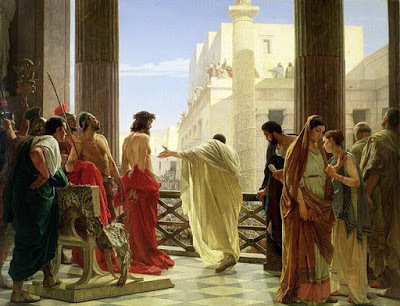 Ecco Homo -- Behold the Man, Antonio Ciseri, 1860-1880,
Ecco Homo -- Behold the Man, Antonio Ciseri, 1860-1880,
Museo Cantonale d'Artz. [PD-US]
The Passover and the Feast of Unleavened Bread
were to take place in two days’ time.
So the chief priests and the scribes were seeking a way
to arrest him by treachery and put him to death.
They said, “Not during the festival,
for fear that there may be a riot among the people.”
When he was in Bethany reclining at table
in the house of Simon the leper,
a woman came with an alabaster jar of perfumed oil,
costly genuine spikenard.
She broke the alabaster jar and poured it on his head.
There were some who were indignant.
“Why has there been this waste of perfumed oil?
It could have been sold for more than three hundred days’ wages
and the money given to the poor.”
They were infuriated with her.
Jesus said, “Let her alone.
Why do you make trouble for her?
She has done a good thing for me.
The poor you will always have with you,
and whenever you wish you can do good to them,
but you will not always have me.
She has done what she could.
She has anticipated anointing my body for burial.
Amen, I say to you,
wherever the gospel is proclaimed to the whole world,
what she has done will be told in memory of her.”
Then Judas Iscariot, one of the Twelve,
went off to the chief priests to hand him over to them.
When they heard him they were pleased and promised to pay him money.
Then he looked for an opportunity to hand him over.
On the first day of the Feast of Unleavened Bread,
when they sacrificed the Passover lamb,
his disciples said to him,
“Where do you want us to go
and prepare for you to eat the Passover?”
He sent two of his disciples and said to them,
“Go into the city and a man will meet you,
carrying a jar of water.
Follow him.
Wherever he enters, say to the master of the house,
‘The Teacher says, “Where is my guest room
where I may eat the Passover with my disciples?”’
Then he will show you a large upper room furnished and ready.
Make the preparations for us there.”
The disciples then went off, entered the city,
and found it just as he had told them;
and they prepared the Passover.
When it was evening, he came with the Twelve.
And as they reclined at table and were eating, Jesus said,
“Amen, I say to you, one of you will betray me,
one who is eating with me.”
They began to be distressed and to say to him, one by one,
“Surely it is not I?”
He said to them,
“One of the Twelve, the one who dips with me into the dish.
For the Son of Man indeed goes, as it is written of him,
but woe to that man by whom the Son of Man is betrayed.
It would be better for that man if he had never been born.”
While they were eating,
he took bread, said the blessing,
broke it, and gave it to them, and said,
“Take it; this is my body.”
Then he took a cup, gave thanks, and gave it to them,
and they all drank from it.
He said to them,
“This is my blood of the covenant,
which will be shed for many.
Amen, I say to you,
I shall not drink again the fruit of the vine
until the day when I drink it new in the kingdom of God.”
Then, after singing a hymn,
they went out to the Mount of Olives.
Then Jesus said to them,
“All of you will have your faith shaken, for it is written:
I will strike the shepherd,
and the sheep will be dispersed.
But after I have been raised up,
I shall go before you to Galilee.”
Peter said to him,
“Even though all should have their faith shaken,
mine will not be.”
Then Jesus said to him,
"Amen, I say to you,
this very night before the cock crows twice
you will deny me three times.”
But he vehemently replied,
“Even though I should have to die with you,
I will not deny you.”
And they all spoke similarly.
Then they came to a place named Gethsemane,
and he said to his disciples,
“Sit here while I pray.”
He took with him Peter, James, and John,
and began to be troubled and distressed.
Then he said to them, “My soul is sorrowful even to death.
Remain here and keep watch.”
He advanced a little and fell to the ground and prayed
that if it were possible the hour might pass by him;
he said, “Abba, Father, all things are possible to you.
Take this cup away from me,
but not what I will but what you will.”
When he returned he found them asleep.
He said to Peter, “Simon, are you asleep?
Could you not keep watch for one hour?
Watch and pray that you may not undergo the test.
The spirit is willing but the flesh is weak.”
Withdrawing again, he prayed, saying the same thing.
Then he returned once more and found them asleep,
for they could not keep their eyes open
and did not know what to answer him.
He returned a third time and said to them,
“Are you still sleeping and taking your rest?
It is enough. The hour has come.
Behold, the Son of Man is to be handed over to sinners.
Get up, let us go.
See, my betrayer is at hand.”
Then, while he was still speaking,
Judas, one of the Twelve, arrived,
accompanied by a crowd with swords and clubs
who had come from the chief priests,
the scribes, and the elders.
His betrayer had arranged a signal with them, saying,
“The man I shall kiss is the one;
arrest him and lead him away securely.”
He came and immediately went over to him and said,
“Rabbi.” And he kissed him.
At this they laid hands on him and arrested him.
One of the bystanders drew his sword,
struck the high priest’s servant, and cut off his ear.
Jesus said to them in reply,
“Have you come out as against a robber,
with swords and clubs, to seize me?
Day after day I was with you teaching in the temple area,
yet you did not arrest me;
but that the Scriptures may be fulfilled.”
And they all left him and fled.
Now a young man followed him
wearing nothing but a linen cloth about his body.
They seized him,
but he left the cloth behind and ran off naked.
They led Jesus away to the high priest,
and all the chief priests and the elders and the scribes came together.
Peter followed him at a distance into the high priest’s courtyard
and was seated with the guards, warming himself at the fire.
The chief priests and the entire Sanhedrin
kept trying to obtain testimony against Jesus
in order to put him to death, but they found none.
Many gave false witness against him,
but their testimony did not agree.
Some took the stand and testified falsely against him,
alleging, “We heard him say,
‘I will destroy this temple made with hands
and within three days I will build another
not made with hands.’”
Even so their testimony did not agree.
The high priest rose before the assembly and questioned Jesus,
saying, “Have you no answer?
What are these men testifying against you?”
But he was silent and answered nothing.
Again the high priest asked him and said to him,
“Are you the Christ, the son of the Blessed One?”
Then Jesus answered, “I am;
and ‘you will see the Son of Man
seated at the right hand of the Power
and coming with the clouds of heaven.’”
At that the high priest tore his garments and said,
“What further need have we of witnesses?
You have heard the blasphemy.
What do you think?”
They all condemned him as deserving to die.
Some began to spit on him.
They blindfolded him and struck him and said to him, “Prophesy!”
And the guards greeted him with blows.
While Peter was below in the courtyard,
one of the high priest’s maids came along.
Seeing Peter warming himself,
she looked intently at him and said,
“You too were with the Nazarene, Jesus.”
But he denied it saying,
“I neither know nor understand what you are talking about.”
So he went out into the outer court.
Then the cock crowed.
The maid saw him and began again to say to the bystanders,
“This man is one of them.”
Once again he denied it.
A little later the bystanders said to Peter once more,
“Surely you are one of them; for you too are a Galilean.”
He began to curse and to swear,
“I do not know this man about whom you are talking.”
And immediately a cock crowed a second time.
Then Peter remembered the word that Jesus had said to him,
“Before the cock crows twice you will deny me three times.”
He broke down and wept.
As soon as morning came,
the chief priests with the elders and the scribes,
that is, the whole Sanhedrin held a council.
They bound Jesus, led him away, and handed him over to Pilate.
Pilate questioned him,
“Are you the king of the Jews?”
He said to him in reply, “You say so.”
The chief priests accused him of many things.
Again Pilate questioned him,
“Have you no answer?
See how many things they accuse you of.”
Jesus gave him no further answer, so that Pilate was amazed.
Now on the occasion of the feast he used to release to them
one prisoner whom they requested.
A man called Barabbas was then in prison
along with the rebels who had committed murder in a rebellion.
The crowd came forward and began to ask him
to do for them as he was accustomed.
Pilate answered,
“Do you want me to release to you the king of the Jews?”
For he knew that it was out of envy
that the chief priests had handed him over.
But the chief priests stirred up the crowd
to have him release Barabbas for them instead.
Pilate again said to them in reply,
“Then what do you want me to do
with the man you call the king of the Jews?”
They shouted again, “Crucify him.”
Pilate said to them, “Why? What evil has he done?”
They only shouted the louder, “Crucify him.”
So Pilate, wishing to satisfy the crowd,
released Barabbas to them and, after he had Jesus scourged,
handed him over to be crucified.
The soldiers led him away inside the palace,
that is, the praetorium, and assembled the whole cohort.
They clothed him in purple and,
weaving a crown of thorns, placed it on him.
They began to salute him with, "Hail, King of the Jews!”
and kept striking his head with a reed and spitting upon him.
They knelt before him in homage.
And when they had mocked him,
they stripped him of the purple cloak,
dressed him in his own clothes,
and led him out to crucify him.
They pressed into service a passer-by, Simon,
a Cyrenian, who was coming in from the country,
the father of Alexander and Rufus,
to carry his cross.
They brought him to the place of Golgotha
— which is translated Place of the Skull —,
They gave him wine drugged with myrrh,
but he did not take it.
Then they crucified him and divided his garments
by casting lots for them to see what each should take.
It was nine o’clock in the morning when they crucified him.
The inscription of the charge against him read,
“The King of the Jews.”
With him they crucified two revolutionaries,
one on his right and one on his left.
Those passing by reviled him,
shaking their heads and saying,
“Aha! You who would destroy the temple
and rebuild it in three days,
save yourself by coming down from the cross.”
Likewise the chief priests, with the scribes,
mocked him among themselves and said,
“He saved others; he cannot save himself.
Let the Christ, the King of Israel,
come down now from the cross
that we may see and believe.”
Those who were crucified with him also kept abusing him.
At noon darkness came over the whole land
until three in the afternoon.
And at three o’clock Jesus cried out in a loud voice,
“Eloi, Eloi, lema sabachthani?”
which is translated,
“My God, my God, why have you forsaken me?”
Some of the bystanders who heard it said,
“Look, he is calling Elijah.”
One of them ran, soaked a sponge with wine, put it on a reed
and gave it to him to drink saying,
“Wait, let us see if Elijah comes to take him down.”
Jesus gave a loud cry and breathed his last.
The veil of the sanctuary was torn in two from top to bottom.
When the centurion who stood facing him
saw how he breathed his last he said,
“Truly this man was the Son of God!”
There were also women looking on from a distance.
Among them were Mary Magdalene,
Mary the mother of the younger James and of Joses, and Salome.
These women had followed him when he was in Galilee
and ministered to him.
There were also many other women
who had come up with him to Jerusalem.
When it was already evening,
since it was the day of preparation,
the day before the sabbath, Joseph of Arimathea,
a distinguished member of the council,
who was himself awaiting the kingdom of God,
came and courageously went to Pilate
and asked for the body of Jesus.
Pilate was amazed that he was already dead.
He summoned the centurion
and asked him if Jesus had already died.
And when he learned of it from the centurion,
he gave the body to Joseph.
Having bought a linen cloth, he took him down,
wrapped him in the linen cloth,
and laid him in a tomb that had been hewn out of the rock.
Then he rolled a stone against the entrance to the tomb.
Mary Magdalene and Mary the mother of Joses
watched where he was laid.
Mark 14:1-15:47
The Seekerville bloggers are praying for YOU and for our entire blog community. If you have any special intentions that need additional prayer coverage, leave a request for prayer in the comment section below.
Please join us in praying for the United States--and the world--during this Coronavirus pandemic. Pray for the sick and suffering, for businesses and schools to remain open, for people to be able to work and for our economy to prosper.We are so grateful for all of you—for your friendship and your support!
May the Lord bless you and your families and keep you safe.
Wishing you a prayerful Holy Week!
March 26, 2021
Weekend Edition


If you are not familiar with our giveaway rules, take a minute to read them here. It keeps us all happy! All winners should send their name, address, and phone number to claim prizes. Please send to Seekerville2@gmail.com. If the winner does not contact us within two weeks, another winner may be selected.
Friday 3/19: The winners of copies of Winnie's book The Christmas Journey are Jeanne Takenaka, BK and Lucy Reynolds
Monday: Erica chatted about her relationship with book reviews, what a reader should include, what they shouldn't and how reviews help authors.
Wednesday: Cate was back to talk craft books. The winner of Wired for Story is Lynne.
Friday: Pam was our host on Friday with part IV of her DIY Graphics Design series. If you missed the post, you can read it here.

Monday: Surprise!
Wednesday: Surprise! Friday: Courtney Walsh will be back on Seekerville! Come welcome her and be sure to leave a comment for a chance to win her latest, Is It Any Wonder: A Nantucket Love Story.

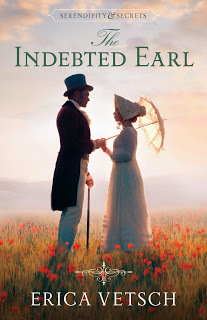
The Indebted Earl released this week! You can get your copy now!
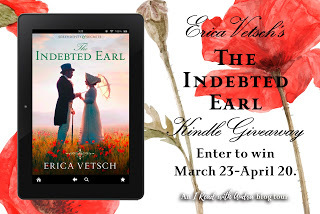
To celebrate, my publisher is giving away a Kindle Fire HD 8"!You can enter to win by clicking on this link to my website:https://www.ericavetsch.com/giveaway.html
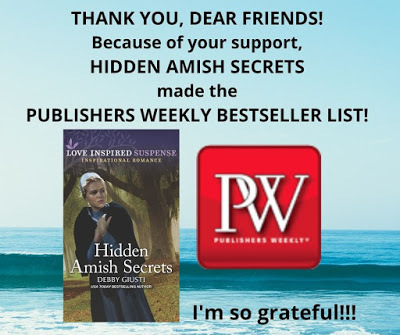
HIDDEN AMISH SECRETS Her temporary Amish homecoming could get her killed. Julianne Graber left her Amish life behind after a family tragedy, but now she’s back to sell the family home— and someone’s dead set on getting rid of her. With her neighbor William Lavy by her side, Julianne must uncover dangerous secrets to make sense of the past and present. Can she find justice for her family—and a future with Will—before the killer hits his target?
Order HERE!

The Huge Truth My Characters Taught Me About Trusting God by Jessie Mattis
How to Make Your Author Newsletter a Priority in Your Sales Game by LA Sartor at Book Brush Blog
Is It Sticky? by Catherine McKenzie at Writer Unboxed
Archetypal Character Arcs, Pt 7: The Mage Arc by KM Weiland at Helping Writers Become Authors
Iconic Tales in Your Novel by Peter Leavell at Learn How To Write A Novel
How to Show (and Not Tell) Without Raising Your Word Count by Janice Hardy at Fiction University
How to Design a Book Cover That Sells by David Gaughran
What is Your Character's Emotional Shielding and Why Does It Matter by Becci Puglisi at Writers Helping Writers
Choosing Your Self-Publishing Strategy as an Independent Author by Lewis Jorstad at The Novel Smithy
4 Tips to Add Conflict to Your Story by Ane Mulligan at The Write Conversation
March 25, 2021
DIY Graphics Design Tutorial: Blending Photos to Create Book Covers (Part Four)

Well, I'm back with Part IV of my DIY graphics design series. If you missed the previous posts, here are the links: DIY Graphics Design Tutorial: STOCK IMAGES (Part One), DIY Graphics Design Tutorial: PHOTO EDITING USING PICMONKEY (Part Two), DIY Graphics Design Tutorial: Fonts, Titles, Series Logos (Part Three).
By request, today's post focuses on how to use the programs and resources covered in Parts I, II, and III to create DIY book covers by merging two or more photos to create attractive covers.
First, it takes a professional graphics artist with high grade software to mash, smash, mix, and combine multiple photos of landscapes and people and make it all look as if it was all taken together. I'm not a professional. I'm a rank amateur and a DIY guru. The covers I've created aren't meant to look as if they were photos taken that way. But there are techniques to get around that obstacle.
So, let's get started...
The untouched photos of the woman and the landscape below were chosen to compliment each other. Ideally the photo of the woman would have had a bluer sky to make it easier to "merge" the two photos, but I decided to work with this one as is. I actually made this "mockup" cover a couple of months ago in preparation for this blog post, but realized I didn't have enough screenshots of the process to show you much of what I'd done. So I created another one yesterday, and decided to show both as they each employ some different techniques.
And, as I was going to "press", a friend shared a great FREE resource that you're going to love! I'll share it at the end.
 horsewoman-4001_1920.jpg
horsewoman-4001_1920.jpg utah-1802033_1920.jpg
utah-1802033_1920.jpgAs you can see from the photos above, neither look like they'd lend themselves to a book cover as in being the appropriate size, although the landscape would make a great wraparound cover for a print book. You'd just have to add more blue sky and clouds to the image.
But never fear. All I did was crop both photos until I got the look I wanted. I added a blue sky background behind the woman and then used a blue sky/cloud-looking swath across the middle to blend the two images. This created the perfect spot to add a title.
Now... you can still see a bit of white around the woman, but I liked the way it lended an airbrushed look, so, all in all, for a sample book cover, I was pleased with it.
I used Picmonkey to create this covers, and the Basic Graphics tool to create the faded edges and cloud effect on the cover below. I'm sorry that I didn't save more steps to show you how I did this. (That's why I created two covers for this project, so I could show you some of the specific steps.)
And... I notice I use the words "layers" and "flattened" a lot in this post. This might not be necessary to explain, but each piece (every photo, every grouping of words, every graphic) of a graphics arts piece is a different "layer", that is, until you "flatten" the pieces. Flattening in digital design software is kind of like ... covering something with scraps of cloth, paint, newsprint, letters, words, stamps, (whatever), then painting over everything with Mod Podge. lol You're welcome for the analogy!
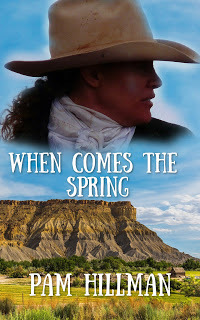
Now on to a cover I created for today's blog post called One Summer in Tuscany. When I realized I didn't have very much step-by-step screenshots to show how to create the above cover, I went to Unsplash and started looking for a landscape that I liked. Any landscape would do, since I didn't have a story idea slot to fill. My "mock" cover could be anything I wanted. If that seems backwards, it is. So, if you're thinking you need something VERY specific for the story you've already written, then read Part I of this blog series. In Part I, I cover how important it is to search for and save photo ideas for future projects.
So, let's pretend I'm writing a book set in Tuscany. :)
First, I found the beautiful Tuscany landscape below and could just picture it was working for a book cover. Then I searched for couples, but didn't find anything that jumped out at me. Ideally, I was looking for a couple or a woman outdoors and with a muted background that would work well with the landscape. I found the blonde woman wearing the hat, but she didn't really work for the look I wanted, even though the muted background would make working with her image fairly easy. I kept looking and found the beautiful woman with dark hair. The background was going to be a bit harder to work with, but the look of the woman fit the Tuscany landscape SO much better, and I was excited to work on the project.
 Unedited Photos Downloaded from Unsplash
Unedited Photos Downloaded from UnsplashOriginally, I planned to create a cover on the same lines as the Western-style cover above (titled When Comes the Spring for lack of a more appropriate title): a landscape on the bottom with the woman on the top half, separated by a banner of some sort. But as soon as I uploaded the Tuscany landscape to PicMonkey, my plans changed. I could see that this cover idea could be so much more...
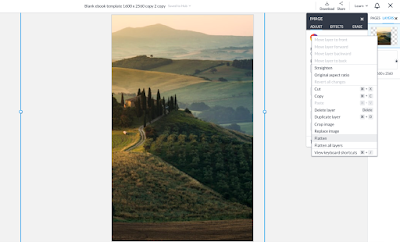 Screenshot #1
Screenshot #1Screenshot #1, above, shows the landscape image uploaded to my book cover template (templates are covered in Part II of this blog series), cropped to the size I wanted for the cover, then FLATTENED. Flattened anchors or "glues" (like that mod podge we talked about) that image as the background. It's your first layer. You don't have to do this step, but it helps if you're pretty sure you've got that layer just as you want it.
 Screenshot #2Screenshot #2 shows where I uploaded the dark-haired woman before I had edited it at all. It's a new layer on top of the landscape layer. It's obviously way too big, but I wanted to leave it that way so that I could see enough to erase the parts I didn't want. The old eyes aren't what they used to be!
Screenshot #2Screenshot #2 shows where I uploaded the dark-haired woman before I had edited it at all. It's a new layer on top of the landscape layer. It's obviously way too big, but I wanted to leave it that way so that I could see enough to erase the parts I didn't want. The old eyes aren't what they used to be!Also, I'm explaining ALL about erasing, but wait until the end when I share the cool new website I just learned after I did all this work. :)
 Screenshot #3
Screenshot #3When you click on any layer/image in Picmonkey, a toolbox called IMAGE appears on the screen. To erase parts of the image, choose erase and adjust the parameters to fit your needs. I wanted to erase all the hard edges around the photo, as well as ALL of the background around her.
 Screenshot #4
Screenshot #4As a matter of fact, when I started, I planned to just keep her face, but she looked really funny with that hand on her chin. lol (And I liked her longer hair). Also, the "dangling" hand as well as her left arm with the wet shirt-sleeve looked totally out of place. Erase. Erase. I just slowly edited out until I hit just the right balance.
 Screenshot #5
Screenshot #5With a few more tweaks, I knew I was really close to a decent mix of these two photos that (to me) would make a gorgeous cover. Screenshot #5, above, is the landscape background and the cover model with NO filters applied to either.
 Screenshot #6, "Tuscany Screen"
Screenshot #6, "Tuscany Screen"Now, let's play with filters. Sometimes, an author (or her editorial team), will decide to fade the model (or some other portion of a cover) for whatever reason. It might be a play on something in the novel... say, the heroine has amnesia and her memory is foggy. Or the title was something like "When Love Fades" or "Memories of You". You get the drift. To achieve these effects, use the Image Tool and play with the BLEND MODES. Screenshot #6 shows the results of using the SCREEN mode. Screen mode achieves a slightly different effect than just FADING, which is also an option on the Image tool. The more you play with Blend Modes, the more uses you'll find for each and learn the best times to employ them on different projects.
 Screenshot #5 again. NO filters applied. I called this "Tuscany Normal"
Screenshot #5 again. NO filters applied. I called this "Tuscany Normal"At this point, I was very happy with Screenshot #5, aka "Tuscany Normal", and after I let the images settle, if I was truly ready to publish this book, with this title, I'd probably go with that nice, sharp image above.
 "Tuscany Faded"
"Tuscany Faded"But sometimes you have to play with the options to see what works and what doesn't. The photo of the girl above is faded just a tiny bit from Tuscany Normal. Just enough to let a tiny bit of the background to show through. If you look closely, you can see it in the duller look of her lips, and the way the horizon cuts through her hair toward her eyes. Using fade works in some situations and not in others. It's just a matter of preference.
 Tuscany Screen
Tuscany ScreenHere's Tuscany Screen again with the actual filter applied, which shows a LOT of blending of the model into the background. It's not a technique I'd use on a cover unless I had a really good reason.
 Tuscany Smudge
Tuscany SmudgeTo achieve Tuscany Smudge I used the Textures filter, which shows up on left of the screen. There are tons of options under this from Wood, Water, Marble, Papyrus, Ice, and on and on. Again, Tuscany Smudge is a bit over the top, not an option I'd chose, but it might work if the filter wasn't applied with such a heavy hand. Maybe just a tiny bit might be okay.
Oh, and BIG TIP. For Tuscany Smudge above, I FLATTENED both the landscape background and the cover model before I applied the Smudge filter. Otherwise, the filter would have only been applied to whichever image (layer) I'd selected. And, it's possible to apply different filters to different layers if you find you need to do that. Just know as you're working which layer you're working on and/or if the layers have been flattened first. (Sorry, that's getting a bit complicated, and I promised to keep it simple. :)
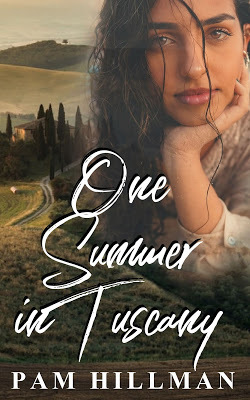 One Summer in Tuscany MOCK Cover
One Summer in Tuscany MOCK CoverTada! We have a cover. I used Tuscany Faded to create this cover, but again, if I really had a novel set in Tuscany, I'd probably go with the original no-filtered photo of the model.
Now, for the cool new software that I just found out about. And, it's FREE! While babysitting two of my grands just today (well, yesterday by the time you read this), my daughter-in-law's mom came by and we started talking about fun projects. She enjoys creating all the stuff you can do with a Cricut: mugs, t-shirts, etc. She told me about this cool site that removes the background of a photo and you can save your photo with a transparent background. While I manually edited out the backgrounds of both of my models for today's projects, there are lots of times I could have used this site. So I definitely plan to add it to my toolbox for later. Pretty cool, huh?
>>>>> www.remove.bg <<<<<
"Download" is free. "Download HD" will accrue a charge. I used Download for the following image.
 Tuscany model with background removed using remove.bg
Tuscany model with background removed using remove.bgOkay, I think I've covered everything, and since it's nearly midnight and I'm out of time, we're going LIVE! Hope y'all enjoyed today's post and learned more tricks and techniques to create amazing graphics, whether for book covers, memes, or even t-shirts for your next family reunion.
 CBA Bestselling author PAM HILLMAN was born and raised on a dairy farm in Mississippi and spent her teenage years perched on the seat of a tractor raking hay. In those days, her daddy couldn't afford two cab tractors with air conditioning and a radio, so Pam drove an Allis Chalmers 110. Even when her daddy asked her if she wanted to bale hay, she told him she didn't mind raking. Raking hay doesn't take much thought so Pam spent her time working on her tan and making up stories in her head. Now, that's the kind of life every girl should dream of. www.pamhillman.com
CBA Bestselling author PAM HILLMAN was born and raised on a dairy farm in Mississippi and spent her teenage years perched on the seat of a tractor raking hay. In those days, her daddy couldn't afford two cab tractors with air conditioning and a radio, so Pam drove an Allis Chalmers 110. Even when her daddy asked her if she wanted to bale hay, she told him she didn't mind raking. Raking hay doesn't take much thought so Pam spent her time working on her tan and making up stories in her head. Now, that's the kind of life every girl should dream of. www.pamhillman.comMarch 23, 2021
Cate's Favorite Writing Books Series - #2
Hello everyone. It's that time of the month again. I'm back with another craft book post and giveaway.
This week I'm sharing a post I did many years ago on the original Seekerville.
Wired for Story: The Writer's Guide to Using Brain Science to Hook Readers from the Very First Sentence. By Lisa Cron
How can a title like that not snag your interest?

The back cover blurb says:
Imagine knowing what the brain craves from every tale it encounters, what fuels the success of any great story, and what keeps readers transfixed. Wired for Story reveals these cognitive secrets - and it's a game changer for anyone who has ever set pen to paper.
That was enough to convince me to purchase a copy! (Clearly bookstores have reason to love me!)
I'm really, really glad I did. I've learned so much about storytelling from this book. My copy is full of Post its and underlining and notes written in the margins. I read and thought about my stories, realized where I was going wrong, and got excited about new ways to do it right. And I've learned to look at story in a whole new light.
The book is chock full of so many interesting points that I'd need a month of posts to do it justice. Rather than doing a poor job summarizing, I'm hoping to whet your appetite with some of the more intriguing thoughts, and prompt some discussion on your thoughts about neuroscience and writing.
I also want to use this study of brain science and story as a lens to look at our roles as writers of inspirational fiction.
Calgon Take me Away
Any of you who are a certain age may recall the Calgon ads - usually a harried housewife pleading, "Calgon, take me away."
Stories have always been my Calgon. The one reliable escape from madness.
But according to Lisa Cron, I've had it all wrong. Stories aren't about escape, but rather about survival.
"Recent breakthroughs in neuroscience reveal that our brain is hardwired to respond to story; the pleasure we derive from a tale well old is nature's way of seducing us into paying attention to it." (p. 1)
And why do we have to pay attention?
To survive.
Lisa Cron discussed her book on Writer Unboxed saying,
"By letting us vicariously experience difficult situations and problems we haven’t actually lived through, story bestows upon us, risk free, a treasure trove of useful intel, just in case. And so back in the Stone Age, even though those shiny red berries looked delicious, we remembered the story of the Neanderthal next door who gobbled ‘em down and promptly keeled over, and made do with a couple of stale old beetles instead."
So story is essential to our survival.
What does that have to do with us as writers?
Because of the way our brains are wired, we respond in certain ways. According to Cron, this explains why some stories captivate us while others leave us cold.
She claims writers often mistakenly believe that beautiful prose and fascinating plots make good stories.
Wrong!
Have you ever read a beautifully crafted writing sample that left you feeling nothing? Or one that was so perfectly structured you were conscious of the craft? By contrast, books that are universally acknowledged as horribly written often become mega best sellers.
Why?
Because they appeal to our cravings for story.
What makes a story work is that inescapable need for the brain to know what is going to happen next. That's what keeps us awake at night reading. Curiosity is roused. Your survival instincts kick in. It's a drug - literally. A dopamine* rush.
Sounds easy, right?
Apparently that's another way we go wrong.
Because stories engage our attention effortlessly, they seem easy to write. And that's where our job can become difficult.
"Not only do we crave story, but we have very specific hardwired expectations for every story we read." (p. 10)
For the remainder of the book, Cron goes through these expectations step by step, explaining how we can create our stories in a manner that gives readers that dopamine high. Each section begins with a Cognitive Secret and a related Story Secret.
There's so much more information about mirror neurons, plot expectations, the protagonist as her own worst enemy, meeting reader expectations, etc. So much good stuff that not only do I seriously recommend this book for your own reading, but I'm going to give away a copy to one lucky commenter. More about that in a bit.
Now I'd like to shift the focus slightly. Seeing that this is Seekerville and most of us write inspirational fiction, I couldn't help but think of discussing this book with our particular writing in mind.
We're following in the footsteps of the greatest storyteller ever known. Jesus taught with stories to make lessons accessible and meaningful to his people.
As I read Wired for Story, I couldn't help but wonder, can we use the discoveries of neuroscience to help build the Kingdom of God?
Early in the book, Cron writes;
"Writers can change the way people think simply by giving them a glimpse of life through their characters' eyes. They can transport readers to places they've never been, catapult them into situations they've never dreamed of, and reveal subtle universal truths that just might alter their entire perception of reality." (p. 2)
That can be a powerful burden or an awesome opportunity.
There's so much wonderful information in this book about how to carefully craft your story to meet reader expectations. I think we could easily learn to adapt those techniques to subtly craft a message that inspires.
So what do you think?
Are you interested in learning more about how neuroscience can help you craft engaging stories?
Do you think we should use this knowledge and these skills to evangelize?
Did I thoroughly confuse you?
I can't really begin to do neuroscience credit in one blog post, so I'm offering a copy of Lisa Cron's book, Wired for Story (ebook or paper), as a prize. Please let us know in the comments if you want to be in the drawing. Winner announced in the Weekend Edition.
If you're interested in more information, Lisa Cron has a website here.
*According to Psychology Today, Dopamine is a neurotransmitter that helps control the brain's reward and pleasure centers. Dopamine also helps regulate movement and emotional responses.
March 21, 2021
One Author's Relationship with Reviews

TOMORROW my newest book releases! #39!! The Indebted Earl, book three in the Serendipity & Secrets Regency series officially comes out, though review copies went out a few weeks ago and some retail places have shipped early. I’m so excited for this book to get into readers hands, and to find out what people think about it. Which got me to thinking about reviews and my relationship with them.
There are lots of things to say and think about book reviews, and I’ll try to bullet point them here for clarity. I apologize for the long post, but there are so many things to say!

What is a book review?
Simply, it’s a reader’s thoughts on a book. What they liked or didn’t like, felt, or enjoyed about a book. Would they recommend this book? Why or why not?It often includes a rating…one to five stars, one being “BLECH, hated this,” five being “BEST book ever!” Amazon now allows you to rate a book without leaving a review...but the written review means more and is more helpful to both the author and the consumer than just a star rating.Posted on social media, often in a variety of places. Book sellers, blogs, Instagram, Facebook, or other social platform. The wider the dispersion of reviews, the more people can be reached with word about the book!
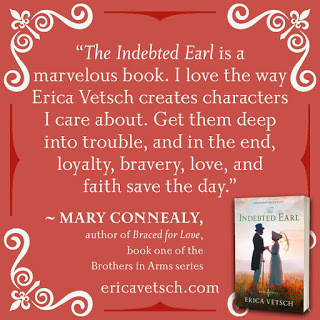
What does a book review do for an author? (This is not an exhaustive list, but it should cover most of the basics.)
Increases visibility in different ways. The more written reviews a book has on retail sites like amazon, Barnes & Noble, or Christianbook, the more these platforms will spread the word about the book. It will be seen in the “Also bought” ribbon across the middle of other book listings, it will appear as suggested for you on people’s amazon home pages and it becomes a bit of a self-fulfilling prophecy. The more popular a book is, the more it will be promoted, and thus become more popular. In addition, a book that is shared on Instagram or FB is seen by thousands as it gains momentum. In one three day ‘Social Media Takeover Tour’ I participated in, my book cover was seen by nearly 90,000 people who otherwise wouldn’t have known about my story. I received word from several people that they "just had to buy the book, because they were seeing it EVERYWHERE!" Yay! Just the result for which I hoped!It gives the author feedback. Reviews are a good way for an author to get feedback on their stories. When our books go to press, we have very little way to know if the story is resonating with readers other than by reviews and feedback. We can judge whether we've hit the mark with our story, is it being well received, is there anything we should change in the next one based on what readers are saying?Encouragement (and discouragement upon occasion) Writing is a solitary existence. Authors are in their heads, creating story worlds, and not knowing the impact our words will have, until we hear through reviews that we’ve nailed it…or not. (More about that later.)Gives a good metric to our publishers on how the books are doing. If you’re getting lots of good feedback through reviews, the publisher is more likely to sign you to another contract than if there are terrible reviews or worse…crickets.The number of reviews a book has can edge it into promotional goldmine territory such as BookBub. In order to qualify for some promotions on sites like BookBub, a book needs to have already gained a certain amount of traction via reviews. Positive book reviews increase sales. People are more likely to buy a book that has many positive reviews than one that has very few. People are more likely to see a book on a retail site if it has positive reviews. There are certain benchmarks that the amazon algorithm has that increases visibility for books that have 50, 100, 200 reviews.

What does a book review do for a reader?
Saves time and money. Reading reviews, especially well-crafted reviews, helps a consumer know whether they will like a product.Introduces the reader to unknown-to-them authors. Through increased visibility, it’s easier for readers to find you on the retail sites. Gives comparisons so readers can identify easily the style of book they're thinking of buying. Often a book review will state “Readers of _____________ will enjoy this book.Word of mouth is still the best way to sell something, and by leaving reviews, it’s like word of mouth advertising that allows you to reach WAY more people than if you just stood on a street corner and talked to passers by!
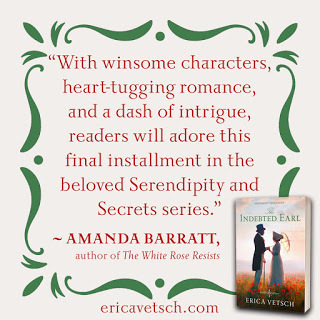
What makes a good, well-written book review?
A good book review will include what you liked and didn’t like. It’s okay to say you didn’t LOVE everything about a book. Was the middle a bit slow? Did it take you some time to get into the story? Did you want to smack the heroine at the beginning? But also include what you DID like. Was the action exciting? Was the romance swoony? Did you relate to the characters’ struggles? A balanced review is more trustworthy than a hit job or a book gush.Keep your review focused on the book, not the author. No personal attacks, please! If you didn’t like the book, it’s okay to say, this turned out not to be to my taste, and to say why, but don’t say something like “This author couldn’t write her way out of a wet paper bag.” That’s just mean.Don’t give away the plot/spoilers. Keep the secrets of the book. You can say, “I never saw the ending coming!” or “The plot twisted more than a rattler slipping through a prickly pear patch!” but don’t give away all the secrets of the book. Knowing all the plot twists and surprises ruins the experience for the next reader and also deflates an author who worked so hard to surprise readers only to have the gaff blown by a reviewer. Please don’t leave a review for something that is outside the author’s control. If the book arrived damaged in the mail, don’t give it a one-star review. The author can’t help what happens in the USPS, and your one star review will bring down the book’s rating average like a cinderblock in a lake.If you received the book through a review program from the publisher, note that at the end of your review, and state that all your opinions are your own. You’re not obligated to leave a favorable review just because you were gifted the book. But you do have to let people know if you received a free copy.
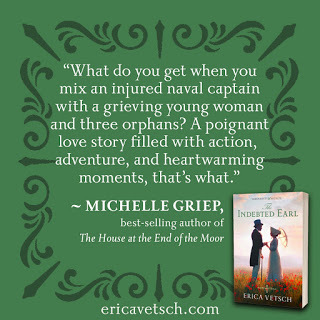
The relationships of authors and reviews:
· I’ll say it up front. It can be difficult when someone says your baby is ugly. Especially the first time you hear it. You can walk in the humiliation of it all day. And for some authors, they never get over reading an unfavorable review.It is LOVELY to read a review that not only is positive, but one where you KNOW the reader totally got what you were trying to say in telling your story. Both the total number and the number of positive reviews can be so encouraging to an author (for the reasons stated above.)There are dangers for authors reading reviews. If you are sensitive to comments about your work that are less than praiseworthy, my advice is to not read them. Let a friend read them and report back if there are any trends or common issues. A trusted friend, not a frienemy who will delight in your pain! Don’t let negative comments derail you, keep you from writing new words, or make you want to answer back…and also…NEVER answer a reviewer back. Ultimately, Reviews are for Readers! Authors can certainly use them, but reviews are for helping potential customers decide whether to buy your book. It’s a bad look if you come spitting out of the gate to contest every review you don’t like. On the flip side, don’t let your ego become inflated by positive reviews praising your work. Certainly enjoy that readers are liking what you wrote, be encouraged, but also remember, the results of your work are in God’s hands, and He deserves the praise.
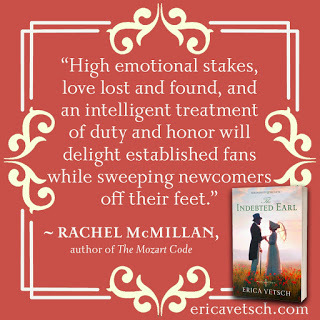
Tips for when you get a bad review: Stop. Take a breath. Walk away from the computer/phone/screen if necessary.When you can be objective, consider if there is any truth to the review. Is there something you need to take under advisement.Remember that art is subjective, and not everyone is going to respond the same way. You have likes and dislikes when it comes to fiction reading, so allow others to have the same preferences.Take a peek at that person's other reviews. Do they consistently leave bad reviews and slate people? Is your book an outlier, or is this a pattern? If it's a pattern, write it off as someone else's problem, not yours.Remember that there is not a single troll out there leaving mean reviews who is living a better life than you. They might be having a bad day, a bad patch, or just be a negative person, but you don't need to give them the power to turn you into the same.If a review is particularly nasty, there are a couple things you can do. If it's on Goodreads, and the review violates their community guidelines, you can flag the review and Goodreads will take a look at it and see if it needs reviewed. If it's just a star rating, there isn't anything you can do about that. Readers are welcome to rate your book however they like, but they are not welcome to attack you in a written review in a way that violates the guidelines. When I checked amazon, here's what they had to say: "If a Product review is in violation of any of those outlined on the link above, simply click the 'Report Abuse' link found just below the review (near the helpful vote buttons), and report it. When it comes to product reviews, Amazon provides a bit of anonymity for buyers who wish to leave Product Reviews." Another site suggested this: "Go to the product details page of your product, find the questionable review, and click “report abuse”. Alternatively, you can send an email to community-help@amazon.com and indicate the ASIN of your product, the date and time of the review, the name/pseudonym of the reviewer, and, ideally, a link to the review." Both Goodreads and Amazon strongly suggest you not respond to the negative review yourself, as this just tends to escalate things, and you never come off looking very good.
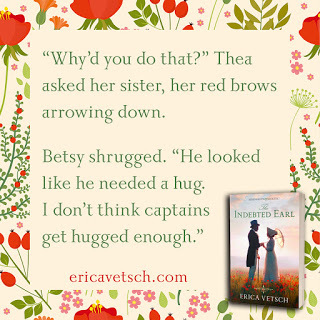
So there you have it. As reviews come in for my newest release, I’m trying to take my own advice! And if you have read/are reading/will read The Indebted Earl…help a girl out! Leave a review and tell your friends!
My question for you….Do you write and post reviews? Do you read reviews before buying a book? If you’re an author, do you read your reviews?
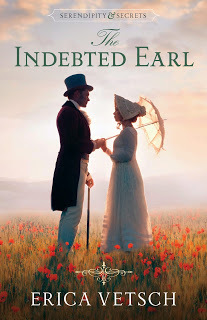 Can Captain Wyvern keep his new marriage of convenience all business--or will it turn into something more?
Can Captain Wyvern keep his new marriage of convenience all business--or will it turn into something more?Captain Charles Wyvern owes a great debt to the man who saved his life--especially since Major Richardson lost his own life in the process. The best way to honor that hero's dying wish is for Wyvern to escort the man’s grieving fiancée and mother safely to a new cottage home by the sea. But along the way, he learns of another obligation that has fallen on his shoulders: his uncle has died and the captain is now the Earl of Rothwell.
When he and the ladies arrive at his new manor house in Devon, they discover an estate in need of a leader and a gaggle of girls, all wards of the former earl. War the new earl knows; young ladies and properties he does not. Still wishing to provide for the bereaved Lady Sophia Haverly, Charles proposes a marriage of convenience.
Sophie is surprised to find she isn't opposed to the idea. It will help her care for her betrothed's elderly mother, and she's already fallen in love with the wayward girls on the Rothwell estate. This alliance is a chance to repay the captain who has done so much for her care, as well as divert her attention from her grief. When Wyvern returns to his sea commission, she'll stay behind to oversee his property and wards.
It sounds so simple. Until the stalwart captain is arrested on suspicion of smuggling, and Sophie realizes how much he's come to mean to her. Now she'll have to learn to fight, not only for his freedom but also for his love.
 Best-selling, award-winning author Erica Vetsch loves Jesus, history, romance, and sports. When she’s not writing fiction, she’s planning her next trip to a history museum and cheering on her Kansas Jayhawks and New Zealand All Blacks. You can connect with her at her website, www.ericavetsch.com where you can read about her books and sign up for her newsletter, and you can find her online at https://www.facebook.com/EricaVetschAuthor/ where she spends way too much time!
Best-selling, award-winning author Erica Vetsch loves Jesus, history, romance, and sports. When she’s not writing fiction, she’s planning her next trip to a history museum and cheering on her Kansas Jayhawks and New Zealand All Blacks. You can connect with her at her website, www.ericavetsch.com where you can read about her books and sign up for her newsletter, and you can find her online at https://www.facebook.com/EricaVetschAuthor/ where she spends way too much time!March 20, 2021
Sunday Scripture & Prayer Requests
Fifth Sunday in Lent
 Early Christian Catacomb painting of Jesus and his disciples,
Early Christian Catacomb painting of Jesus and his disciples,
pre-third century. [PD-US]
Some Greeks who had come to worship at the Passover Feast
came to Philip, who was from Bethsaida in Galilee,
and asked him, “Sir, we would like to see Jesus.”
Philip went and told Andrew;
then Andrew and Philip went and told Jesus.
Jesus answered them,
“The hour has come for the Son of Man to be glorified.
Amen, amen, I say to you,
unless a grain of wheat falls to the ground and dies,
it remains just a grain of wheat;
but if it dies, it produces much fruit.
Whoever loves his life loses it,
and whoever hates his life in this world
will preserve it for eternal life.
Whoever serves me must follow me,
and where I am, there also will my servant be.
The Father will honor whoever serves me.
“I am troubled now. Yet what should I say?
‘Father, save me from this hour’?
But it was for this purpose that I came to this hour.
Father, glorify your name.”
Then a voice came from heaven,
“I have glorified it and will glorify it again.”
The crowd there heard it and said it was thunder;
but others said, “An angel has spoken to him.”
Jesus answered and said,
“This voice did not come for my sake but for yours.
Now is the time of judgment on this world;
now the ruler of this world will be driven out.
And when I am lifted up from the earth,
I will draw everyone to myself.”
He said this indicating the kind of death he would die.
John 12:20-33
The Seekerville bloggers are praying for YOU and for our entire blog community. If you have any special intentions that need additional prayer coverage, leave a request for prayer in the comment section below.
Please join us in praying for the United States--and the world--during this Coronavirus pandemic. Pray for the sick and suffering, for businesses and schools to remain open, for people to be able to work and for our economy to prosper.We are so grateful for all of you—for your friendship and your support!
May the Lord bless you and your families and keep you safe.
March 19, 2021
Weekend Edition


If you are not familiar with our giveaway rules, take a minute to read them here. It keeps us all happy! All winners should send their name, address, and phone number to claim prizes. Please send to Seekerville2@gmail.com. If the winner does not contact us within two weeks, another winner may be selected.
Monday: Jan Drexler talked about keeping the promises we make to our readers by following through with our story hooks.
Tuesday: Kimberly Duffy visited us with a blog post celebrating her newest release, A Tapestry of Light, and teaching us some tips for "Writing What you Know." The winner of a copy of A Tapestry of Light is: Vivian Furbay! Congratulations and be sure to contact us at the above address to claim your prize!
Wednesday: Debby Giusti celebrated St. Patrick's Day with her blogpost, "B’Gosh and B’Gora a New Book and a Bit of This and That!" The winner of Debby's latest release, HIDDEN AMISH SECRETS, is Edwina! Congrats, Edwina!!! Contact the blog with your home address via the address above.
Friday: Winnie Griggs shared the method she uses to track her story's timeline of events. Return later today to learn who the winner(s) of a copy of her book The Christmas Journey are.

Monday: Erica Vetsch is talking all about book reviews! What they are, how to write them, how to respond to them, and how they benefit authors and readers alike!
Wednesday: Cate Nolan is our hostess. She'll be talking about another favorite craft book, and you'll have another chance to win a copy. Stop by to see what part of craft we're studying this week. Friday: Pam Hillman plans to return to her DIY Graphics Design series, that is, if life doesn't get in the way. See y'all on Friday!

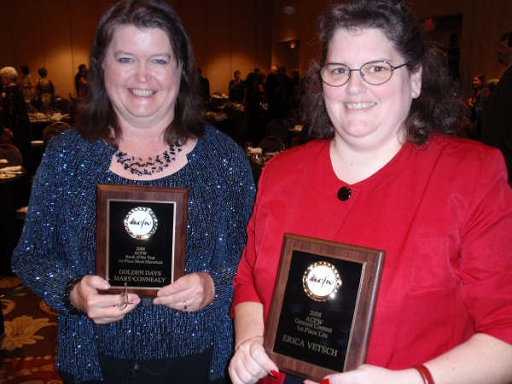
This week, Mary Connealy and I (Erica) celebrated our birthdays! Turns out, in addition to being a dear friend, (and one of my longest-known writing friends) Mary is also my birthday twin! I met Mary in a bookstore in downtown Rochester MN many moons ago when she was on her very first book signing tour for her very first book! The picture above is from 2008, when Mary won an ACFW Carol Award, and I won an ACFW Genesis award! Mary has been friend, cheerleader, Seekerville sister, and so much more through the years. Here's to many more 'twinning' birthdays, Mary! You are so loved!

HIDDEN AMISH SECRETS Her temporary Amish homecoming could get her killed. Julianne Graber left her Amish life behind after a family tragedy, but now she’s back to sell the family home— and someone’s dead set on getting rid of her. With her neighbor William Lavy by her side, Julianne must uncover dangerous secrets to make sense of the past and present. Can she find justice for her family—and a future with Will—before the killer hits his target?March 9, 2021Order HERE!

How to Make Your Author Newsletter a Priority in Your Sales by LA Sartor at Book Brush Blog
Why, When and How to do a Cover Reveal by Tari Faris at Learn How To Write A Novel
4 Ways a Strong Point of View Strengthens a Novel by Janice Hardy at Fiction University
How to Self-Publish Audiobooks by Diana Urban at BookBub Blog
Archetypal Character Arcs, Pt. 6 The Crone Arc by KM Weiland at Helping Writers Become Authors
4 Tips on Writing an Epic Fantasy That's Also a Page Turner by Sarah Beth Durst at Writer's Digest
Writing App Roundup with Dave Chesson, Kindlepreneur by Thomas Umstattd, Jr at Steve Laube Agency
Writing Last Lines by Aaron Gansky at Blue Ridge Mountains Christian Writers
Why Successful Novels Need Story Structure by Lewis Jorstad at The Novel Smithy
Tips for Working with a Social Media Assistant by Barbara Linn Probst at Writers In The Storm
How Writers Can Adopt a Successful Mind-set by CS Lakin at Live Write Thrive
3 Things Worth Thinking About BEFORE You Start Your Book by Lucy V Hays at Writers Helping Writers
The Great Ebook Pricing Question by David Gaughran
New Beginnings by Lindi Peterson at Inspy Romance
March 18, 2021
Story Tracking With A Calendar
Hello everyone, Winnie Griggs here again. Today I'm in revising and polishing mode and was checking and updating the story calendar and thought that might be a good topic for my current post.

One of the first things I do when I start a new story is to set up a calendar to help me track story events. First, whether it's an historical or a contemporary, I pull up an actual calendar for the year in question. For purposes of this post, I'm going to use one of my older works, The Christmas Journey, which was set in 1892.
 From www.timeanddate.com
From www.timeanddate.comAs you can see, this gives me a lot of very useful information. It tells me when holidays occurred, when there was a full moon or dark of the moon if that becomes important to my story.
Once I have this information I start populating my story calendar. I add in any fixed events that happen over the course of my story- things like holidays, town events (festivals, civic/club meetings, classes, etc.) A new wrinkle for my Amish stories is they have church service every other Sunday so I note which Sundays are church Sundays and which are "Between Sundays".
If I know the start and end dates for my story I'll mark them. For instance I knew I wanted this story to end on Christmas Day so I plugged that in. I didn't know an actual start date but I estimated based on how many weeks I expected the story to take place over. FYI, my notation legend - Events that are fixed I list in blue text, events I've estimated the date for or am placing on the calendar before I actually write the scene are noted in red text.
So I started out with the calendar below:

As I write the story I begin filling in the story events. If I transition over any of the days, I shade the applicable cells in gray. But if something happened during the transition period that I refer back to, I also make note of it. That way I can see what happens on page and off.

Here is a look at my final calendar for The Christmas Journey with some of the notations deleted to remove most of the key spoilers :)

Using this method allows me to keep up with my story. It keeps me from having a week that lasts nine days or having two Tuesdays in a row or various other timeline issues that I've actually had in the past. I've also started turning it in with my manuscript and my editor has said it's a big help when she's looking at continuity issues during her editing process.
One other thing I've found that this helps - when I'm writing a series of books set in the same town/world, it helps me keep things straight from book to book. The way this works is that any repetitive events I've noted on the calendar from Book 1 gets copied over to my calendar for Book 2. That insures I don't have timeline issues between the two. For instance, if I set up a town council meeting that happens on the second Tuesday of the month in Book 1, I immediately copy that onto my calendar when I start Book 2 as a fixed event. Or if one of my key characters in Book 1 is pregnant when it closes, I track her pregnancy/delivery in the calendar for Book 2.
There you have it, my story tracking method. Let's discuss - does this speak to you? Or do you have a different method that you've developed that works for you?
And since I still have a number of copies of The Christmas Journey, leave a comment to be entered in a drawing for a copy.


Philadelphia lawyer Ryland Lassiter is everything Josephine Wylie wants - for a brother-in-law! As the sole supporter of her family, Josie's plans for herself have always had to wait. But Ryland will be ideal as the new head of the Wylie clan...once he finally realizes how perfect he is for her sister.
Ry knows its time to settle down. The newly appointed guardian to a friend's daughter, he's ready for a home and family. All he needs is a bride...and Josie's sister is not the Wylie who has caught his eye. If only Josie would see the truth - that the only Christmas present he needs is her love.
AMAZON LINK
March 16, 2021
B’Gosh and B’Gora a New Book and a Bit of This and That!
 By Debby Giusti
By Debby Giusti Happy Saint Patrick’s Day, Seekerville! I hope ye be wearing the green and looking for that pot of gold under the rainbow.
I found my pot of gold when Love Inspired Books published my first story in 2007, and I’ve been dancing a jig ever since.
Did ye know March is Irish Heritage Month and the perfect time to announce my new release?
HIDDEN AMISH SECRETS is in bookstores NOW.

The lad and lass in the story grew up Amish, instead of Irish, but the deputy sheriff, Terrence O’Reilly, is as Irish as Paddy’s pig. So I’m calling it an Amish/Irish tale—at least on St. Patrick’s Day!
 A typical thatched roof cottage
A typical thatched roof cottageOkay, I’ll drop the brogue…
Two years ago, before the COVID shutdown, I toured Ireland and wanted to share photos from that fun excursion. The people were friendly and welcoming, and the country was beautiful with quaint villages, picturesque farmland and majestic seascapes. The Cliffs of Moher were especially breathtaking. Surprisingly the weather was delightful with day after day of blue skies and sunshine—and NO RAIN! Undoubtedly, the saints were smilin’ down on us as we toured the Emerald Isle!
 My maiden name is Willoughby so I had to
My maiden name is Willoughby so I had to snap a shot of this quaint pub.
A wee bit of this…
I hosted a writing class at my church pre-pandemic and recently met with one of the “students,” who had just penned her first story. We discussed her manuscript, and the questions she asked were similar to the one’s I’d had when I started my writing journey so I decided to share some of what we talked about that day.
Colleen, as I’ll call her, needed clarification on point of view. I encouraged her to think of the POV character wearing a movie camera on his head. Everything the character sees has to be captured by that camera. If the camera can’t film it, the character can’t see it--thus, it's not in his POV.
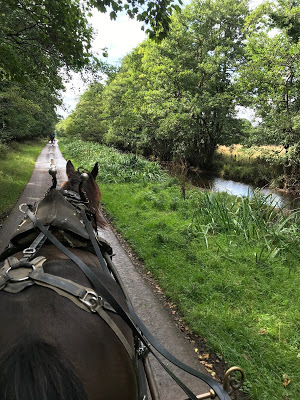 A carriage ride through one of the parks.
A carriage ride through one of the parks.What about multiple points of view? For a romance, the hero and heroine should each have their own POV. Longer books might include a few more characters, but follow the KISS rule and “Keep it simple.”
No head hopping, please. Start each scene in a particular character’s point of view and remain in that character’s POV until the scene is over. The next scene can be in a different character’s POV.
End each scene and chapter with a hook. Pull from your story arcs. The hook can deal with the suspense or the romance or the faith element. Often the hook foreshadows the protagonist’s next problem and should always make the reader want to turn the page and keep reading.
 Castles are a common sight along the highway.
Castles are a common sight along the highway.A number of Colleen’s scenes involved multiple characters. I shared a screenwriting tip. Have two characters talk among themselves while the rest of the group is occupied doing something else. One person in the initial twosome can step away, which allows a third character to move onto the page, all the while the other characters continue to chat quietly among themselves, eat a meal or do something else off stage and out of the limelight. Focusing on two characters at a time prevents the confusion that could ensue when lots of characters are simultaneously embroiled in a discussion.
Whether you’re a plotter or a pantser, plan ahead and have a clear idea of the major scenes, especially the climax, before you begin to write the story. If you’re working in the suspense, mystery or thriller genres, the protagonist must battle the villain, emerge triumphant and solve the crime by the end of the story.
 Cliffs of MoherA little of that…
Cliffs of MoherA little of that… Here are a few off-the-wall things I think about after I know my characters and their GMC but before I begin to write my Amish stories. Which if any of my Amish characters will have a cell phone? Will I need to include a phone shack? Will the characters travel solely by horse and buggy or will an Amish taxi be needed? If my Englisch hero or heroine seeks shelter with an Amish family and must remain with them until the danger passes, how will the visiting character access clothing, toiletries or other personal items? What about the facilities? Indoor plumbing or an outhouse? Since the Amish practice non-resistance, how will the villain be subdued at the climax? Will any characters have access to a weapon? An Englisch character needs to have a good reason to become Amish. What was lacking in the character’s former life that attracts him or her to the Amish faith? If Englisch characters drive a car, what make and model?
 Blarney Castle
Blarney CastleA closing thought…
Last month I mentioned my concern about the erosion of our Freedom of Speech. Since then, more censorship has occurred on various social media platforms. I get a daily medical bulletin from the American Society of Clinical Pathologists, of which I’m a member. Last week, the bulletin mentioned that more than 30,000 medical posts had been removed from various online forums seemingly because they didn’t adhere to the medical practices of the day. I wouldn’t want to get a daily newspaper that had articles blacked out nor would I want to attend an online class if portions of the instructor’s notes had been scrubbed by an arbitrary outside censor before I received them. I wonder what information all those deleted medical posts contained. I don’t know about you, but I’m digging deeper these days to uncover what’s true and what’s not.
 A late afternoon boat ride on one of Ireland's many lakes.
A late afternoon boat ride on one of Ireland's many lakes.An Irish blessing…
May the road rise up to meet you.
May the wind be always at your back.
May the sun shine warm upon your face,
The rains fall soft upon your fields,
And, until we meet again,
May God hold you in the palm of His hand.
Leave a comment or share some Irish trivia or a writing tip or two to be entered in a drawing for HIDDEN AMISH SECRETS!
Happy Writing! Happy Reading! And Happy Saint Patrick's Day!
Debby Giusti
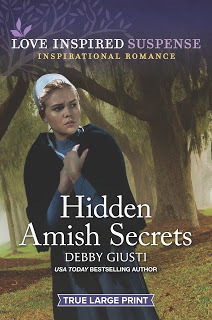
HIDDEN AMISH SECRETS
By Debby Giusti
Her temporary Amish homecoming
could get her killed.
Julianne Graber left her Amish life behind after a family tragedy, but now she’s back to sell the family home— and someone’s dead set on getting rid of her. With her neighbor William Lavy by her side, Julianne must uncover dangerous secrets to make sense of the past and present. Can she find justice for her family—and a future with Will—before the killer hits his target?
Order on Amazon!
March 15, 2021
Writing What You Know by Kimberly Duffy *Giveaway*
Erica here. It is my delight to welcome author Kimberly Duffy to Seekerville today. Kimberly graciously agreed to guest post for us on one of her busiest days--Release Day! She will pop in as she can, and I hope you'll throw lots of encouragement and congrats her way on this big occasion!

Writing what you Know
There are some bits of writing advice that have been repeated so often, and for so long, they’ve become trite. Expected. Eye rolls and indignant huffs and all that. “Write what you know” falls squarely in that category.
I’m a forty-one-year-old homeschooling mother of four. My days consist of multiplication drills, read alouds, and running my kids all over God’s green Earth.
No one wants to read that story.
If we all wrote what we knew then there’d be a heck of a lot of boring autobiographies masquerading as novels cluttering bookstore shelves.
Except…
this is fantastic advice that’s been misinterpreted.
Write what you know isn’t about plot. It’s about emotion.
I don’t know what it’s like to be a 19th century women wanting to work in a male-dominated field, but I do know what it’s like to be discounted because of my sex. I know what it’s like to be told I’m too masculine and forceful and driven and not soft enough.
I may not fully understand what it’s like to process extreme grief and how that weighs on a personal faith, but I identify with the doubt and questioning and fear that comes along with being unmoored.
I have no idea—no idea at all—what it means to be a suffragette, an Ancient Roman Christian, a woman who has been cheated on, or a person with magical powers.
But I certainly know what it’s like to feel desperate, fearful, betrayed, and unworthy.
That’s why we read fiction, right? That’s why we continue with a story that has nothing to do with our every day other than the emotions threaded through it. Novels take us out of our own lives, yes, but they also anchor and validate and encourage us in our experiences.
I’m often asked if I put myself in my stories. And the answer to that is a resounding “yes!” In every book, there are pieces of me scattered throughout the chapters. Here a little bit of my personality, there my questions, this thing I learned during my darkest moment, that bit of feeling I’d stored away.
There are a few things I do so that my stories are authentic and my characters relatable.
1. Don’t be afraid to let your characters be ugly. I’ve yet to meet a perfect person (and those who come close are more annoying than inspirational!) I don’t set out to write likeable characters; I set out to write characters with real flaws that readers can see themselves in. Now, I like my characters, but I know others won’t. And that’s okay. It’s real life.
2. Draw from your experience. Those things we hold most tightly are the things that are very likely to give life to our books. They’re the things others desperately need to know they aren’t alone in. I experienced a trauma about twenty years ago that I gave to a character. Was it hard to write? Absolutely. It’s something I rarely talk about. But in giving my words to her, I was able to redeem the loneliness and isolation of those moments. And because it comes from a very personal place, I hope others who have experienced something like it will feel seen and heard.
3. Consider method-writing. Have you heard of method-acting? Method-writing is similar in that you put yourself in your characters’ shoes. If they’re lost in the woods during a snowstorm and it’s August where you live, try opening the freezer and holding a frozen roast for a few minutes. If you’re getting ready to write a kissing scene, practice on your spouse. That all might sound silly, but even a superficial understanding of what your character is experiencing goes a long way in creating believability.
Writing this way demands an author’s transparency and vulnerability, but it’s made worth it by stories that resonate with people, regardless of those things you, or your characters, do or don’t have in common with your reader. In a world fractured by differences, it’s good to remember those things that knit us together.
Erica here again. As I mentioned above, today is Release Day for Kimberly's second novel, A Tapestry of Light! Isn't this cover STUNNING?
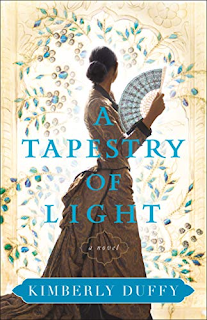
Here's a bit about the book: Calcutta, 1886.
Ottilie Russell is adrift between two cultures, British and Indian, belonging to both and neither. In order to support her little brother, Thaddeus, and her grandmother, she relies upon her skills in beetle-wing embroidery that have been passed down to her through generations of Indian women.
When a stranger appears with the news that Thaddeus is now Baron Sunderson and must travel to England to take his place as a nobleman, Ottilie is shattered by the secrets that come to light. Despite her growing friendship with Everett Scott, friend to Ottilie's English grandmother and aunt, she refuses to give up her brother. Then tragedy strikes, and she is forced to make a decision that will take Thaddeus far from death and herself far from home.
But betrayal and loss lurk in England, too, and soon Ottilie must fight to ensure Thaddeus doesn't forget who he is, as well as find a way to stitch a place for herself in this foreign land.
This is book 2 in Kimberly's debut series. Book one is:
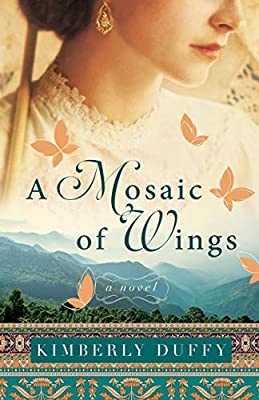
It's 1885, and all Nora Shipley wants, now that she's graduating from Cornell University as valedictorian of the entomology program, is to follow in her late father's footsteps by getting her master's degree and taking over the scientific journal he started. The only way to uphold her father's legacy is to win a scholarship, so she joins a research expedition in Kodaikanal, India, to prove herself in the field.
India isn't what she expects, though, and neither is the rival classmate who accompanies her, Owen Epps. As her preconceptions of India--and of Owen--fall away, she finds both far more captivating than she expected. Forced by the expedition leader to stay at camp and illustrate exotic butterflies the men of the team find without her, Nora befriends Sita, a young Indian girl who has been dedicated to a goddess against her will.
In this spellbinding new land, Nora is soon faced with impossible choices--between saving Sita and saving her career, and between what she's always thought she wanted and the man she's come to love.
Kimberly Duffy is a Long Island native currently living in Southwest Ohio. When she's not homeschooling her four kids, she writes historical fiction that takes readers back in time and across oceans. Her books feature ahead-of-their-time heroines, evocative settings, and real-life faith. Kimberly loves trips that require a passport, recipe books, and practicing kissing scenes with her husband of 20 years. He doesn't mind.
You can find Kimberly at:
www.kimberlyduffy.com
https://www.facebook.com/AuthorKimberlyDuffy/
https://www.instagram.com/kimberlyduffyauthor/
Kimberly is giving away a copy of her new release, A Tapestry of Light to one person who comments today. In keeping with the topic of Writing What You Know...If you are a writer, what are some of the ways you have incorporated your own experience into your writing? If you're a reader, what are some topics you love to read about? Answer below to be entered to win!



